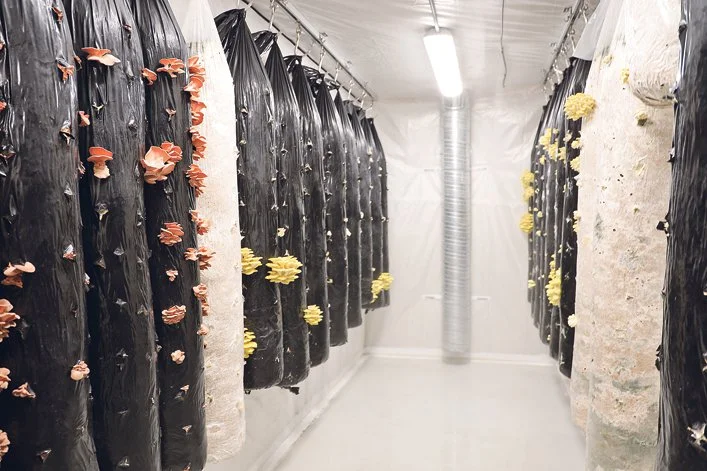Indoor Farm Started In A Shipping Container
September 26, 2019
Rachel Yadlowski shows some of the mushrooms grown in her family’s indoor farm. | Mary MacArthur photo
An Alberta family’s mushroom operation sells its produce to wholesale markets, restaurants, hotels and specialty stores
NISKU, Alta. — The Gruger Family Fungi farm has come a long way since its beginning in a metal shipping container. Today the mushroom farm is in a warehouse in an oilfield industrial park.
There may not be soil, gravel roads and quarter sections of land, but Rachel Yadlowski believes their warehouse bay is a new kind of farming.
“We are farming in a warehouse. It’s an indoor farm,” said Yadlowski, who operates the farm along with her husband, Carleton Gruger, and other family members.
“It’s a different kind of farming. It’s a different way of producing nutrition all year around.”
This farm doesn’t grow just one crop, it grows a colorful collection of tree-loving mushrooms few people have heard of, seen, or eaten.
The pink oyster mushroom has a subtle bacon flavor, while the blue oyster becomes soft and velvety when cooked. The gold oyster has “fruity notes” and the king oyster is nutty and cashew-like. The lion’s mane mushroom looks like cauliflower and tastes like lobster.
And those are just the eating mushrooms. The family grows reishi and codyceps for tinctures and creams sold for their health benefits.
For hundreds of years, mushrooms have been an important part of people’s diet as a source of protein and healing powers. Yadlowski wants to bring mushrooms back as an important part of our diet.
“We’ve lost our mushroom knowledge.”
Yadlowski has been making converts from her farmers market table and now from the grocery store promotion booth since the family fungi business started in 2015. When customers look at the strangely shaped fungi, they’re worried the mushrooms she sells are not safe to eat, or are just too strange to eat.
Almost half of their customers are vegan, buying mushrooms for their high level of protein. A growing number of chefs and home cooks want to incorporate the unique flavoured mushroom into foods. The mushrooms are now sold through wholesale markets, restaurants, hotels and specialty stores.
The process of raising mushrooms begins in the laboratory with spores grown in a petri dish.
“This is where we’re cultivating the seed for our fungi farm.”
The spores are added to jars of sugar water and then splashed into a bag of warm wheat grain to grow and expand. That bag is added to a mixture of hemp herd, hemp heart screens and mash from the nearby Rig Hand Distillery.
“It’s all nutrition for our mushrooms.”
The mycelium-rich mixture is mixed together in the mushroom mash mixing machine before it’s heated, cooled and squished into long, plastic-shaped logs and hung in one of 13 climate-controlled growing rooms.
Pink, blue and gold oyster mushrooms grow on artificial logs in special climate controlled rooms. | Mary MacArthur photo
“We are creating artificial logs.”
In two weeks the pink, gold and blue mushrooms are poking out of the bags and picking begins. It takes about three weeks before the king oyster mushrooms can be harvested.
“Keeping the rhythm on our farm is important. We always have to make sure there is good rotation.”
In 2017, growing mushrooms was still a hobby, but the demand by restaurants for a more regular supply of unique mushrooms pushed the family to jump into mushroom production on a larger scale. The first harvest at their Nisku farm was March 2018 and with more demand and improved processes, they can double production on their farm at the same location.
When the mushroom growth in the rooms slows down, the logs still filled with thousands of mycelium are sold to home gardeners, spread onto soil and the mushroom growing continues in the backyard.
“Mushrooms give back that life and invite more micro-organisms back to the soil.”
ABOUT THE AUTHOR
Mary MacArthur's recent articles
Farm puts out welcome mat for trees September 19, 2019
Alberta greenhouse closure sign of a tough business September 12, 2019


